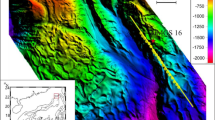Abstract
To investigate the distribution and velocity attributes of gas hydrates in the northern continental slope of South China Sea, Guangzhou Marine Geological Survey conducted four-component (4C) ocean-bottom seismometer (OBS) surveys. A case study is presented to show the results of acquiring and processing OBS data for detecting gas hydrates. Key processing steps such as repositioning, reorientation, PZ summation, and mirror imaging are discussed. Repositioning and reorientation find the correct location and direction of nodes. PZ summation matches P- and Z-components and sums them to separate upgoing and downgoing waves. Upgoing waves are used in conventional imaging, whereas downgoing waves are used in mirror imaging. Mirror imaging uses the energy of the receiver ghost reflection to improve the illumination of shallow structures, where gas hydrates and the associated bottom-simulating reflections (BSRs) are located. We developed a new method of velocity analysis using mirror imaging. The proposed method is based on velocity scanning and iterative prestack time migration. The final imaging results are promising. When combined with the derived velocity field, we can characterize the BSR and shallow structures; hence, we conclude that using 4C OBS can reveal the distribution and velocity attributes of gas hydrates.
Similar content being viewed by others
References
Amundsen, L., 2001, Elimination of free-surface related multiples without need of a source wavelet: Geophysics, 66(1), 327–341.
Burch, D. N., Calvert, A. S., and Novak, J. M., 2005, Vector fidelity of land multicomponent measurements in the context of the earth-sensor system: misconceptions and implications: 75th Annual International Meeting, SEG, Expanded Abstracts, 904–907.
Cantillo, J., Boelle, J. L., Lafram, A., and Lecerf, D., 2010, Ocean-bottom nodes (OBN) repeatability and 4D: 80th Annual International Meeting, SEG Expanded Abstracts, 61–65.
Gong, Y. H., Wu, S. G., Zhang, G. X., Wang, H. B., Liang, J. Q., Guo, Y. Q., and Sha, Z. B., 2008, Relation between gas hydrate and geologic structures in dongsha islands area of south china sea: Marina Geology & Quaternary Geology (in Chinese), 28(1), 99–104.
Grion, S., Exley, R., Manin, M., Miao, X. G., Pica, A., Wang, Y., Granger, P. Y., and Ronen, S., 2007, Mirror imaging of OBS data: First Break, 25(11), 37–42.
Guevara, S. E., and Stewart, R. R., 1998, Multicomponent seismic polarization analysis: CREWES Research Report, 10.
Hugonnet, P., Boelle, J. L., Herrmann, P., Prat, F., and Lafram, A., 2011, PZ summation of 3D WAZ OBS receiver gathers: 73nd EAGE meeting, Expanded Abstract, 30.
Hyndman, R. D., and Davies, E. E., 1992, A Mechanism for the Formation of Methane Hydrate and seafloor bottom simulating reflectors by vertical fluid expulsion: Journal of Geophysical Research, 97(B5), 7025–7041.
Kvenvolden, K. A., 1993, Gas hydrates-geological perspective and global change: Reviews of Geophysics, 31(2), 173–187.
Li, L., Lei, X. H., Zhang, X., and Sha Z. B., 2013, Gas hydrate and associated free gas in the Dongsha Area of northern South China Sea: Marine and Petroleum Geology, 39(1), 92–101.
Pang, X., Chen, C. M., Peng, D. J., Zhou, D., Shao, L., 2009, Basic Geology of Baiyun deep water area in the North part of Nanhai: China Petroleum Geology Society, 2009, 20(4), 215–222.
Riedel, M., Spence, D., Chapman, N. R., and Hyndman, R. D., 2001, Deep-sea gas hydrates on the northern cascadia margin: The leading edge, 87–92.
Shi, X. F., and Yan, Q. S., 2011, Geochemistry of Cenozoic magmatism in the South China Sea and its tectonic implications: Marine Geology and Quaternary Geology, 31, 59–72.
Soubaras, R., 1996, Ocean-bottom hydrophone and geophone processing: Proceedings of the Society of Exploration Geophysicists, 24–27.
Wang, Y., Bale, R., and Grion, S., 2010a, A new approach to remove the water column effect from 4D ocean bottom data: 80th SEG Annual Meeting, 4205–4209.
Wang, Y., Grion, S., and Bale, R., 2010b, Up-down deconvolution in the presence of subsurface structure, 72nd EAGE meeting, Expanded Abstract, D001.
Yi, H., Zhong, G. J., and MA, J. F., 2007, Fructure characteristics and basin evlution of the Taixinan basin in genozoic: Petroleum Geology & Experiment (in Chinese), 29(6), 560–564.
Zhang, G. X., Liang, J. Q., LU J. A., Yang, S. X., Zhang, M., Su, X., Xu, H. N., Fu, S. Y., and Kuang, Z. G., 2014a, Characteristics of natural gas hydrate reservoirs on the northeastern slope of the South China Sea: Natural gas industry (in Chinese), 34(11), 1–10.
Zhang, G. X., Xu, H. N., Liu, X. W., Zhang, M., Wu, Z. L., Liang, J. Q., Wang, H. B., and Sha, Z. B., 2014b, The acoustic velocity characteristics of sediment with gas hydrate revealed by integrated exploration of 3D seismic and OBS data in Shenhu area: Chinese Journal of Geophysics (in Chinese), 57(4), 1169–1176.
Author information
Authors and Affiliations
Corresponding author
Additional information
This research is supported by the National Hi-tech Research and Development Program of China (863 Program) (Grant No. 2013AA092501) and the China Geological Survey Projects (Grant Nos. GZH201100303 and GZH201100305).
Sha Zhi-Bin graduated from China University of Geosciences (Wuhan) in June 1994. He is a presently a PHD. student in the Department of Marine Geology, Faculty of Resources, China University of Geosciences (Wuhan). His research interests are seismic surveying of gas hydrates.
Rights and permissions
About this article
Cite this article
Sha, ZB., Zhang, M., Zhang, GX. et al. Using 4C OBS to reveal the distribution and velocity attributes of gas hydrates at the northern continental slope of South China Sea. Appl. Geophys. 12, 555–563 (2015). https://doi.org/10.1007/s11770-015-0515-z
Received:
Revised:
Published:
Issue Date:
DOI: https://doi.org/10.1007/s11770-015-0515-z



